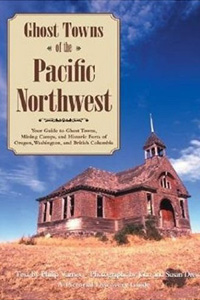
Pacific Northwest Book Review
The Pacific Northwest area went through many profound changes after its abundant natural resources were “discovered” by settlers and prospectors in the 19th Century. Towns and cities appeared overnight in remote places in order to harvest raw resources for export, then turned into ghost towns or disappeared completely once those resources had been exhausted.
Most of the people who lived and worked in these early boom/bust towns are ghosts now, and the only trace of their existence survives in cemeteries, newspaper articles, personal letters, journal entries and historical photographs that reveal giant saw mills, timber trestled railroad bridges, large factories, public buildings, hotels and opera houses that have long-since vanished.
Philip Varney’s “Ghost Towns of the Pacific Northwest” documents many of the early logging towns, mining camps, sea ports and early forts of the Pacific Northwest area, but having personally visited most of the places in the book, it is a stretch to call many of them ghost towns, as this implies a place that is completely abandoned.
Varney’s 2005 book is filled with striking photographs by John and Susan Drew of historical buildings that still stand, some in disrepair and others maintained and preserved as tourist attractions. There are no people in the Drew’s photographs, just picturesque empty streets, empty cemeteries and empty rooms. Varney and the Drews have collaborated on two other books about ghost towns in Colorado and Northern California and Varney has written several other books about ghost towns in Arizona and New Mexico. Neither are natives of the northwest as Varney lives in Tucson, Arizona the Drews live in Jackson Hole, Wyoming.
This is a good guide book for history hunters who like to visit places first-hand for the full experience and prefer to travel by car on main highways. Many of the charming little towns like Roslyn or Oysterville are fun to explore and imagine what life was like during the town’s heyday.
The most common cause of a once-thriving Pacific Northwest town’s decline into ghost town status was an economy centered around a single, highly profitable natural resource that suddenly became exhausted due to unsustainable practices. Once all the timber had been logged or the minerals had been mined and sent off to distant places, the local economy dried up, the workforce population moved away and the purpose of the town ceased to be. Other times, the demand for resources suddenly changed due to outside economic factors such as falling prices and greater competition.
Philosophically, these ghost towns reveal the brief triumph of man over nature in our ability to develop wild areas in order to extract valuable natural resources, but there is an irony or poetic justice in nature’s ability to reclaim these places after the people move away. Wooden structures burn, rot or collapse over time without our care and preservation, abandoned metal equipment rusts or is salvaged by others, and after a few decades of neglect, the wilderness reclaims the land for herself.
Editor’s note: Varney and Voyageur Press published a smaller, updated version of this 2005 book in 2013 without the Drew photographs that has the ISBN: 9780760343166.
Reviewed by John Morgan, 6/20/2015
Ghost Towns of the Pacific Northwest
"Ghost Towns of the Pacific Northwest:
Your Guide to Ghost Towns, Mining Camps and Historic Forts of Oregon, Washington and British Columbia"
By Philip Varney
Published in 2005 by
ISBN-13: 978-0896585928

Contact the Pacific Northwest Book Review by e-mail at editor@pnwbookreview.com or by mail at P.O. Box 550, Toledo, WA 98591.
About Us. Copyright © 2026 Pacific Northwest Book Review. All rights reserved. Website powered by Morgan Online Media LLC.